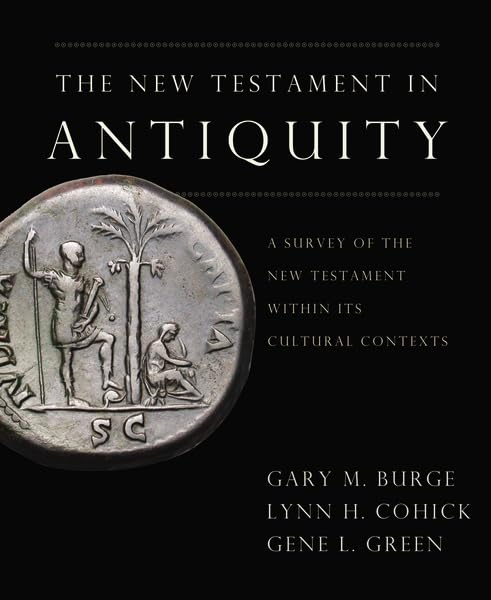The New Testament in Antiquity: A Survey of the New Testament within Its Cultural Contexts
Written by Gary M. Burge, Lynn H. Cohick, and Gene L. Green Reviewed By Paul J. BrownThe authors of this survey, three Wheaton College professors, have provided Christian college faculty with a fresh base-text for their undergraduate NT introduction or entry-level graduate survey courses. Each author contributes in his or her area of expertise, creating a strong collaboration that avoids the unevenness of a single-author survey. Many of the features included in this text are typical of the most recent NT surveys—engaging and informative color-photographs and maps, sidebars citing important primary source materials, and end-of-chapter discussion questions. What sets this volume apart from the proliferation of NT surveys is its combination of critical engagement with the pressing issues of NT studies, accessible format, and commitment to an evangelical perspective. The authors’ self-stated goals in writing the book are academic rigor, broad accessibility, contextual sensitivity, and confessional faithfulness (p. 9).
The text is organized into twenty-seven chapters of varying lengths (10–27 pp.). As expected, the survey begins with background material. It differs from others, however, in the amount of space devoted to the ancient context. Since one of the book’s contributions is its attention to the Greco-Roman and Jewish settings, the authors have chosen to devote the first 164 pages to backgrounds, beginning with the broad Greco-Roman and Jewish historical context and gradually narrowing to the story of Jesus. The student first encounters the exposition of the NT text with the Gospel of Matthew in chapter 8, followed by the remaining Gospels and Acts. After a chapter focusing on the life and theology of Paul, his epistles are discussed, beginning with Galatians as the first epistle written and proceeding chronologically. The General Epistles receive similar treatment; the authors lead the group with James and combine Jude with 1 and 2 Peter. The final chapter is devoted to the transmission of the NT text after the completion of its writing; it broaches issues of textual criticism, canon formation, and translation theory.
Several attributes contribute to the value of this text. The overall perspective is decidedly evangelical (traditional dating and authorship prevails), but leaves in-house debates open for discussion and engagement (e.g., the discussion of the New Perspective on Paul [p. 264] and the genre of Revelation [p. 427]). The authors consistently address these issues charitably and even-handedly, and at times openly share their personal views (e.g., the meaning of “head” in 1 Cor 11 [p. 306]). The regular appeal to the cultural context for informing interpretations brings greater clarity and significance to otherwise opaque or insignificant details in the text of Scripture (cf. the question posed to Jesus about paying taxes [p. 156]). Although many survey texts include photographs and illustrations, the photographs in The New Testament in Antiquity are exceptional, not merely gratuitous; they contribute to a better understanding of the world in which the NT was penned. These qualities make the text commendable and useful within the evangelical community across confessional lines.
This elegantly written text accomplishes the four stated goals effectively for the “alert undergraduate” students that the authors teach (p. 9). Professors may find a judicious use necessary when teaching in settings where the students’ intellectual curiosity is less broadly shared or where the NT course is the first Bible course of a general education sequence. Specifically, some students may find the significant space devoted to cultural backgrounds exhilarating while others may struggle to remain engaged until they embark upon the reading and study of the NT text itself. In addition, the level of engagement with critical issues may be more than some students can meaningfully digest. For these situations, the text is adaptable to the specific pedagogical needs. The text is not only usable in the academy, however. It could be used profitability as a reference for Sunday school teachers or a NT reading guide for the interested laity in the local church. In whatever way it is used, the authors have provided a valuable and up-to-date tool for the Christian community.
Paul J. Brown
Trinity Evangelical Divinity School
Deerfield, Illinois, USA
Other Articles in this Issue
We want to understand how the power of God comes into our preaching...
Martin Luther was a pastor-theologian. He worked out his theology in the midst of teaching, preaching, participating in public controversy, and meeting all kinds of pastoral needs...
Bearing Sword in the State, Turning Cheek in the Church: A Reformed Two-Kingdoms Interpretation of Matthew 5:38–42
by David VanDrunenAmong the many biblical passages that provoke controversial questions about Christian non-violence and cooperation with the sword-bearing state, perhaps none presses the issue as sharply as Matt 5:38–42...
Does “Christocentrism” betray an asymmetrical trinitarianism that neglects the Father and the Spirit? The spate of calls for “Christ-centeredness” in evangelicalism’s past few generations collude with the twentieth century’s revivified trinitarianism to prompt this question...
feel honored to be able to give this lecture named after John Wenham...







